The Nerd’s Definitive Guide to 'Rings of Power'
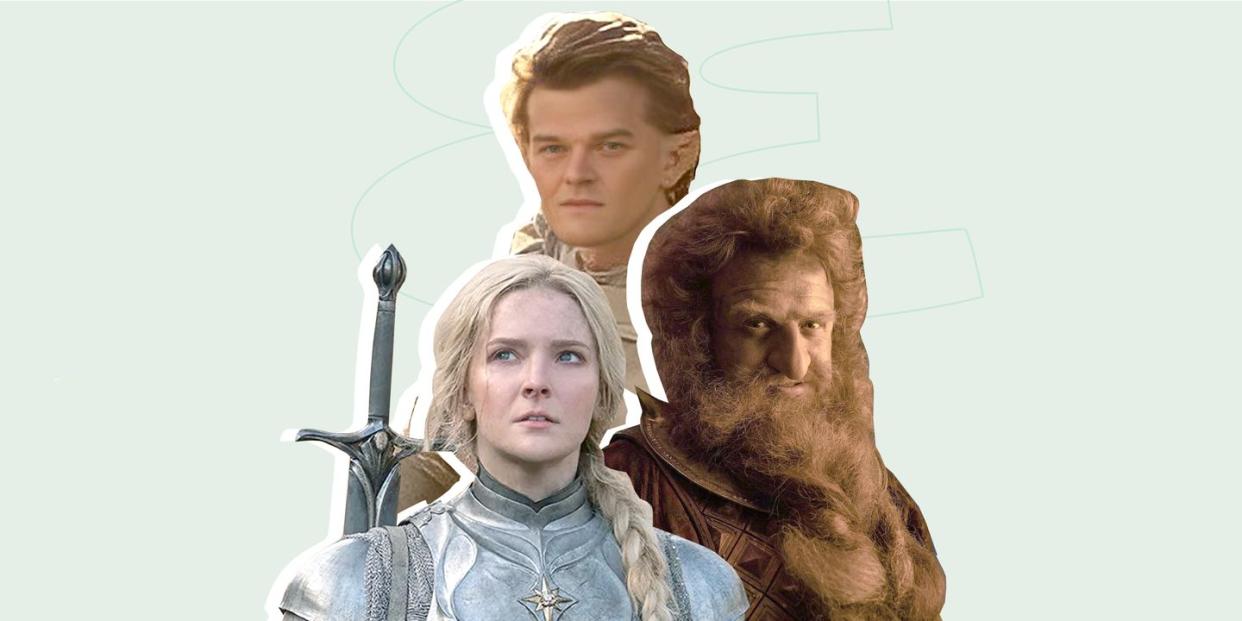
- Oops!Something went wrong.Please try again later.
After years of anticipation, Amazon’s Rings of Power is finally just days away—which means that your time to catch up on J.R.R. Tolkien’s vast legendarium has all but run out. Don’t worry: we can help. Whether you’re a fan of the Peter Jackson trilogy or a true blue newbie, we’ll bring you up to speed on everything you need to know before Rings of Power debuts on September 2.
But first, a word of warning: you can enjoy Rings of Power on its own merits, but if you haven’t seen the Lord of the Rings trilogy, we highly recommend starting there. The films are a vital part of anyone’s cultural education, to be sure, but they’re also an excellent way to ground yourself in Middle-earth before launching into Rings of Power.
Now, strap on your cloak and take up your walking stick. Let’s get into it.
The Ages of Middle-Earth
First things first: if you’re a film fan, you’ll want to understand how the chronology of Rings of Power relates to Lord of the Rings.
The history of Middle-earth is divided into four ages, with each one comprised of many centuries and delineated by earth-shattering events (literally—more on that below). The action movie-goers know and love takes place at the tail end of the Third Age, but as titanic as those events may seem, they’re really just a blip on the radar in the grand scheme of Middle-earth history. To understand where Rings of Power fits into the timeline, we’ll have to wind the clock all the way back to the First Age, which Tolkien chronicles in The Silmarillion. The First Age saw the rise of the Dark Lord Morgoth, a godlike being responsible for all the hatred and evil in Middle-earth. After centuries of endless war, the elves overthrew Morgoth, ushering in the Second Age. This was the longest of Tolkien’s ages, beginning in peace and prosperity—but it wasn’t meant to last. Rings of Power is set during the twilight of the Second Age, when we can expect to see the rise of Sauron, the forging of the Rings of Power, the fall of Númenor, and the Last Alliance of Elves and Men. These events never received their own standalone novel, but Tolkien chronicled them extensively in the appendices to The Return of the King.
Viewers of the films may remember the mythic prologue of The Fellowship of the Ring, in which Galadriel recounts how elves and men joined forces to defeat Sauron. This is The Last Alliance of Elves and Men—AKA, the big event that separated the Second Age from the Third Age.
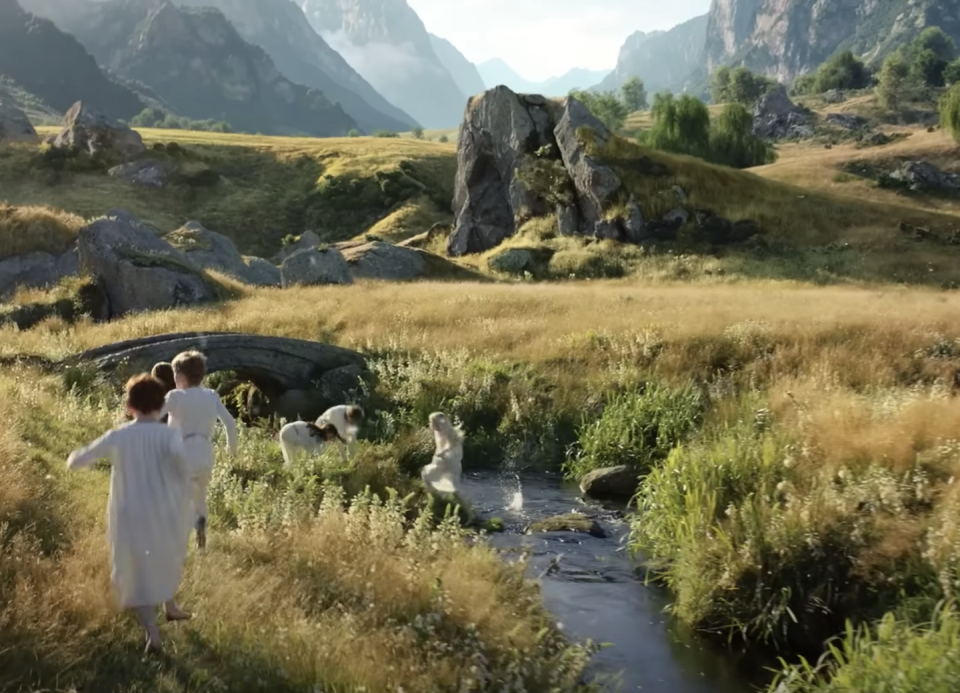
A Handy-Dandy Tolkien Glossary
Like any work of fantasy, Tolkien’s legendarium is full of original terms you’ll need to know, including names, places, and titles. But the maker of Middle-earth had more than just an outstanding imagination—he was also a linguistic genius who started constructing fictional languages in his teens. He brought all those talents to bear on Middle-earth, detailing many languages and etymologies for all the world’s peoples. What does that mean for you, dear Rings of Power viewer? Well, it’s a lot of terms to cram into your head, but we’ve got you covered. We’re going to break this down elementary school style by bringing you up to speed on some of the most important people, places, and things.
People:
Sauron
This guy again? By the time of the Lord of the Rings trilogy, big baddie Sauron has been reduced to a flaming eye in the sky, but earlier in Middle-earth’s history, he looked entirely different. Sauron got his start in villainy as Morgoth’s lieutenant; then, after the boss was defeated, he went into hiding in Middle-earth, concealing himself for centuries. During this chapter of the Second Age, Sauron was a formidable shapeshifter whose greatest power was deception. When he wasn’t busy raising armies and corrupting the hearts of men, Sauron often took the form of Annatar, pretending to be one of the Maiar (helpmeets of the gods who took many forms—Gandalf is one of them). As Annatar, he befriended many elves, instructing them in arts and magic. Some elves distrusted Annatar, like Elrond and Galadriel, but one important elf was enthralled: Celebrimbor, the greatest of all Elven craftsmen, whom Sauron convinced to forge the nineteen Rings of Power. That fateful episode, as movie fans well know, would animate Middle-earth history for thousands of years to come. Later in the Second Age, Sauron made his way to Númenor to sow discord between gods and men (more on that below). Needless to say, we can expect to see a lot of Sauron in Rings of Power, though we’ll have to pay careful attention—he could come in any number of deceptive forms.
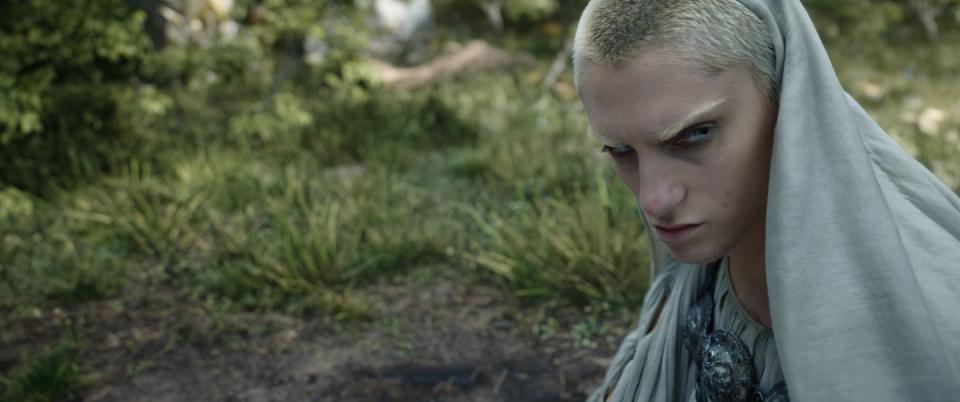
Silvan Elves
We spare you the full genealogical details, but let’s put it this way: Tolkien’s elves aren’t all one big, happy family. The elves are a “sundered” race, divided forever by the decision of some elves to live among gods and others to live among men. After that first Sundering of the Elves, the race continued to divide along regional lines. This matters because Rings of Power promises to highlight one of Tolkien’s lesser-explored groups of elves: the Silvan elves, known for their deep connection to the woodlands. The Silvan elves live in Mirkwood (the realm of Legolas’s father) and Lothlorien (the realm Galadriel rules), though neither Legolas nor Galadriel are Silvan elves. Let’s just leave that one at “it’s complicated.” Rings of Power has created an original Silvan elf for the series in the form of Arondir (played by Ismael Cruz Cordova). Not much is known about the character yet, but he’s bound to shed some light on the Silvan elves’ mysterious way of life.
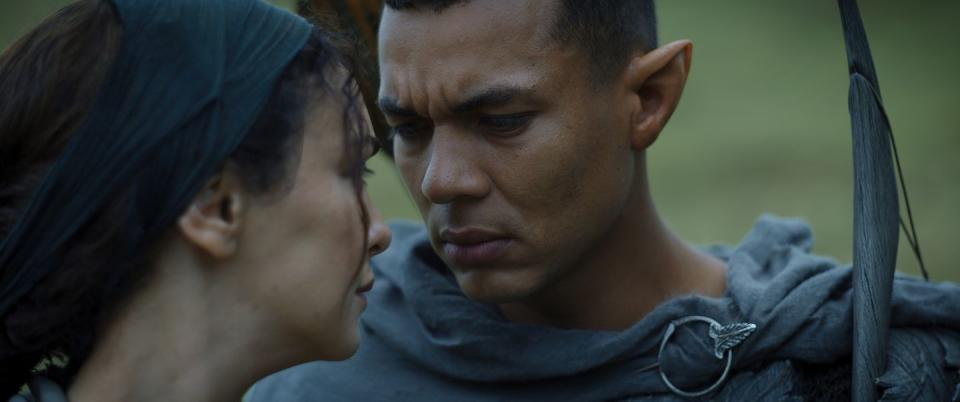
Harfoots
If you thought you saw hobbits in the Rings of Power trailer, think again. Hobbits are the youngest of Tolkien’s fictional races; they didn’t come into being as we know and love them until the Third Age. What you saw in the trailer are the Harfoots, one of the halfling groups that preceded hobbits. During the Second Age, three types of hobbit predecessors wandered Middle-earth: the Harfoots, the Stoors, and the Fallohides. The Harfoots, a group of nomadic halflings who tended to live in Middle-earth’s hills, would eventually mingle with the Stoors and the Fallohides to settle the Shire. None of these groups played a major role in Second Age history, but that doesn’t mean the Harfoots’ Rings of Power stories won’t be exciting. After all, as every Tolkien fan knows, heroes come in all shapes and sizes, and even the unlikeliest people can shape history.
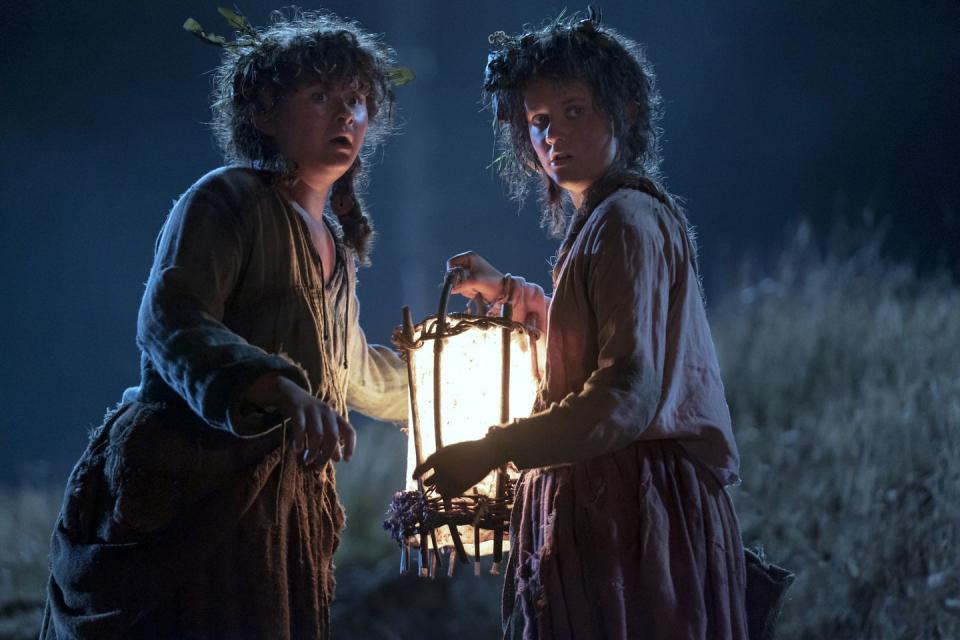
Places:
Valinor
There’s no place in the Tolkien legendarium shrouded in quite so much mystique as Valinor, also known as the Undying Lands or the Blessed Realms. Remember the end of Return of the King, when Frodo boards an elven ship and sails out of Middle-earth forever? He’s headed for Valinor, home to elfkind and the Valar. Bathed in beauty and light, Valinor is a holy land beyond sickness, corruption, and withering.
Though the elves were not born in Valinor, the gods invited them to dwell there early in Middle-earth’s history, which resulted in the Sundering of the Elves. Those who chose to remain in Middle-earth (including some elves we know and love, like Galadriel) would forever be subject to a soul-deep desire to seek out Valinor, which could awaken within them anytime. Sailing for Valinor was both an honor and a homecoming, but elves who ignored the call and overstayed their time in Middle-earth would ultimately “fade,” meaning that their tormented spirits would consume their bodies until they passed through the world like ghosts. These “Lingerers” would be disembodied and sent to the afterlife (which for elves was a physical hall in Valinor, much like Valhalla). Fans of the Peter Jackson films likely remember Elrond’s fear that Arwen would fade, as well as the mass exodus of elves to Valinor that took place during the latter days of the Third Age.
No mortal creature can dwell in Valinor, save for a scant few who received special dispensation: Frodo Baggins, Bilbo Baggins, and Samwise Gamgee, who were given the honor due to their service as Ringbearers; and Gimli, who passed into the West with Legolas. But just because mortal creatures can’t dwell in Valinor doesn’t mean they don’t want to—which brings us to the Númenoreans.
Númenor
Rings of Power will set parts of its story in Númenor, the site of Tolkien’s epic Fall of Númenor. Formed out of the ocean by the Valar and called the Land of Gift, Númenor was an island bequeathed to the men who took up arms against Morgoth alongside the elves. During the Second Age, knowledge, culture, and industry flourished here as the Númenoreans befriended the elves, worshiped the Valar, and used their legendary seafaring skills to explore Middle-earth. But soon, some Númenoreans began to spurn the gods and covet the eternal life of elves. They fell under the sway of Sauron, who promised them immortality in exchange for their aid in his war against the Valar. At Sauron’s urging, Ar-Pharazôn, the last king of Númenor, sent an armada to Valinor to make landfall where no mortal creature could tread—a blasphemous act of war.
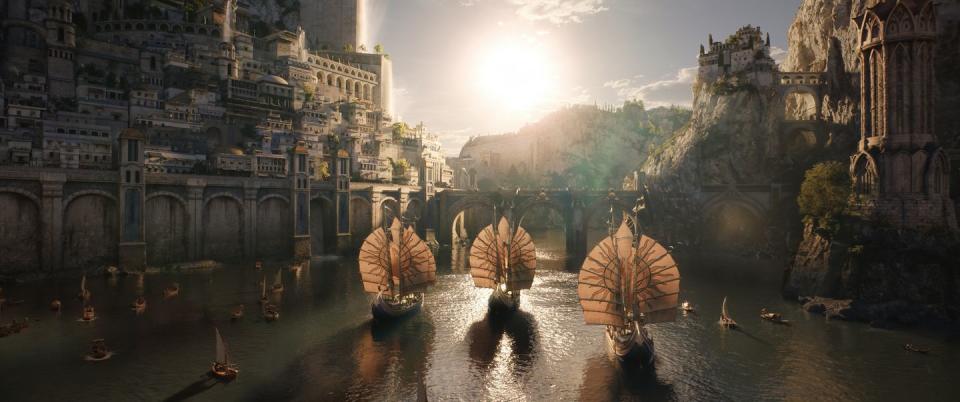
Before the fleet reached the shore, punishment came swift and harsh in an event known as The Changing of the World. Eru Illuvatar, the creator god, transformed the flat Earth into a globe. The ocean subsumed Númenor, drowning everyone on the island but Sauron. Sauron managed to get out with his life, but the cost was great—he lost the ability to shapeshift into fair forms. From that point forward, he could no longer use charm or cunning to manipulate the people of Middle-earth; instead, he would rule by terror and violence. Meanwhile, the “faithful” Númenoreans, who respected the gods and fled before disaster struck, set sail to Middle-earth, where they founded Gondor and gave rise to a long line of kings that would one day include Aragorn. We can expect Rings of Power to dramatize this foundational part of Tolkien’s Second Age mythology.
Lindon
Movie-goers have seen the splendor of elven strongholds like Rivendell and Lothlorien, but the world of the elves is much, much vaster than what’s been committed to celluloid. During the Second Age, many elves lived in Lindon, a kingdom ruled by the High King Gil-galad (expect to meet him in Rings of Power). Lindon’s capital was the Grey Havens, the Elvish port pictured at the end of Return of the King when Frodo departs Middle-earth forever. The Grey Havens were ruled by Círdan the Shipwright, the oldest elf in Middle-earth, who held a Ring of Power and constructed spectacular ships to ferry elves to Valinor. We can expect to meet Círdan in Rings of Power, too.
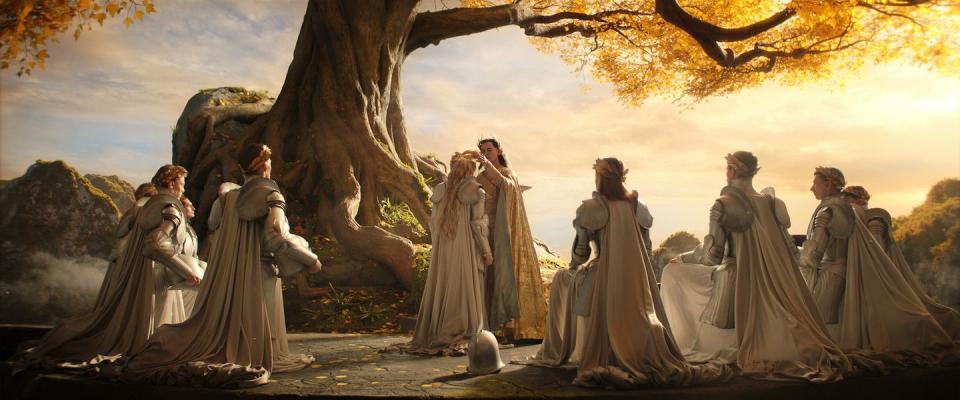
Khazad-dûm
Remember that scene from Fellowship of the Ring when the fellowship passes through Moria, a derelict dwarven kingdom beneath the Misty Mountains? Before Moria fell into ruin, it was known as Khazad-dûm, the most famed and ancient of all the dwarven realms. During the First Age, dwarves thrived in Khazad-dûm, mastering their crafts of smithing, mining, and masonry. The Second Age, a prosperous time of wealth and glory, saw them ally with the elves and discover mithril (the precious metal from which Frodo’s chainmail was made), but it all came to an end when Orcs threatened the dwarves’ halls, forcing them to close their doors to strangers. During the Third Age, the dwarves’ greed and isolation ushered in their doom: in pursuit of precious mithril, they dug too deep into the mountains and released the Balrog, a primordial creature that destroyed their cities and killed most of their people (it would eventually kill Gandalf the Grey in Fellowship of the Ring, too). In Rings of Power, we can look forward to seeing the dwarves in their prime.

Things:
Silmarils
While the Second Age focuses primarily on the creation of the nineteen Rings of Power, we’re likely to hear a lot about the Silmarils, the defining creation of the First Age. These three jewels were the most precious of all the wonders crafted by the elves; according to a prophecy, the fate of the known world was bound up in them. The theft of the Silmarils by Morgoth was the inciting event of the First Age, leading to endless war. Though the Silmarils were recovered, it was only through great peril and loss. Ultimately, the three jewels ended up within the sky, on the floor of the ocean, and beneath the earth. Expect to hear about them in Rings of Power, as these episodes loom large in the memory of elves.
Nimloth
In early footage from Rings of Power, you may have noticed a breathtaking tree wreathed in white petals. We’re guessing this is Nimloth, a legendary tree that grew in the King’s Court on the island of Númenor. Gifted to the men of Númenor by elves, Nimloth symbolized friendship between the two races. It was also a powerful symbol of the House of Elros, the long line of kings that would birth Aragorn; it was prophesied that if Nimloth was destroyed, the House of Elros would perish. The tree was felled at Sauron’s behest, but Isildur saved a seedling and planted it in Middle-earth, where it would grow into the White Tree of Gondor (you may remember it from Return of the King). All of this is to say, keep an eye on Nimloth—it’s an important symbol.
You got all that, folks? Congratulations for making it this far. Stick with us for more Rings of Power coverage, and beware of friendly strangers who might be Sauron.
You Might Also Like

